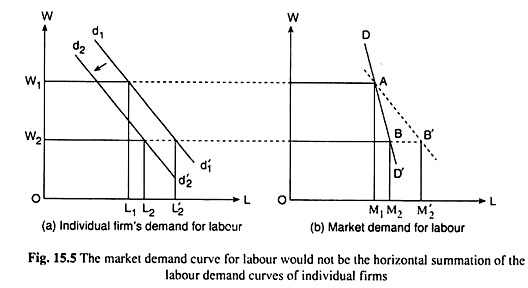In this article we will discuss about the market demand for a variable input under monopoly and imperfect competition, explained with the help of a suitable demand curve.
If a group of monopolists producing different outputs use a particular variable input, then in order to obtain the market demand for the input, we have to simply sum up the individual demands of the monopolists unlike what we did in the case of perfect competition in the product market.
For here there would be no external effects of expanded output on price—the effect of expansion of labour demand and output on price due to a fall in W, is internal to each monopolist, and it has already been taken into account at the time of derivation of his MRPL function and his individual demand curve.
However, the situation is different in the case of monopolistic competition and oligopoly (with or without product differentiation) in the product market. Here the demand curve for a variable input of any one producer is derived in the same way as a monopolist’s demand curve— for any individual firm here, the demand curve for the product is negatively sloped (based on MRPL) and the MRPL curve is different from the VMPL curve.
ADVERTISEMENTS:
But when all the firms in monopolistic competition or oligopoly expand output, market prices of their products diminish as under perfect competition. Therefore, to obtain the market demand for the variable input from individual demands, we have to consider the fall in price (p) and marginal revenue (MR).
For the fall in p and MR would shift the individual MRPL functions to the left, and therefore, would shift their aggregate to left just as the fall in p was responsible for leftward shifts in individual VMPL functions and their aggregate in the case of perfect competition.
We may conclude, therefore, that graphically the derivation of the market demand curve here is exactly the same as that done in Fig. 15.5. The only difference is that here the individual demand curves are based on MRPL rather than on VMPL.
